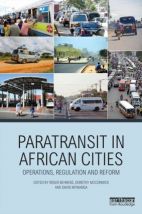Paratransit in African Cities: Operations, Regulation and Reform

Paratransit in African Cities synthesizes findings from an academic research programme supported by the Volvo Research and Educational Foundations. This cross-university and multi-national programme forms the basis for most of the chapters in this book, supplemented by practitioner insights and experiences. Based upon a belief that public transport systems in sub-Saharan African cities are heavily reliant upon paratransit systems, the editors – Roger Behrens, Dorothy McCormick and David Mfinanga – call for improvements to their quality, reliability and coverage. They draw upon three case cities in particular – Dar es Salaam, Cape Town and Nairobi – which offer some insight into the region’s heterogeneity. This book therefore aims to fill a gap in current knowledge about how “paratransit services might be improved and integrated into public transport reform projects” (page 13). To do this, its chapters progress through three main themes:
· The public transport challenges that cities in sub-Saharan Africa face
· Business strategies and aspirations for current paratransit operators in the three primary case study cities
· Policy and strategy options in light of the experiences of paratransit integration and business development
Chapter 2 sets out the state of public transport in Dar es Salaam, Cape Town and Nairobi. It highlights the influence of political, demographic and economic history upon these cities and concludes that greater control by authorities is required if public transport quality is to be improved (pages 54–55). Chapter 3 presents an overview of paratransit operations in order provide a foundation for discussions on paratransit reform later in the book (page 59). In Chapter 4 some of the common political and socioeconomic dynamics of paratransit in Nairobi are analysed through a historical lens in order to identify the politics and policy gaps that currently influence the sector (page 79).
Alternative approaches to paratransit reform are discussed in Chapter 5, to critically review those that have been either implemented or mooted in the region (page 100). Chapter 6 draws upon research in Nairobi to consider “how the diverse business strategies of matatu [minibus] operators result in variations in regulatory compliance” (page 125). It discerns links between strategies, especially business strategies, and levels of compliance (page 147). Chapter 7 turns to Dar es Salaam and its own minibuses, daladalas, to discuss attempts to both transform and integrate the city’s transport systems. This chapter highlights the importance of focusing on operations as well as infrastructure (pages 169 and 171). The case of Cape Town’s paratransit operations – both its aspirations and reform attempts – are reviewed in Chapter 8. The authors present a four-part approach that they deem necessary to improve the transition to the city’s MyCiTi project (page 195).
Chapter 9 broadens the book’s focus by drawing upon experiences of other countries to “critically explore the barriers to comprehensive paratransit replacement” (page 200). It argues that even when scheduled public transport services are successfully installed, people will still depend upon hybrid transport systems for decades to come. Chapter 10 builds on this. Using international cases it identifies, analyses and draws lessons from regulation of hybrid public transport systems. Furthermore it highlights the importance of context in determining appropriate strategies to pursue policy objectives of paratransit recognition and integration (pages 221 and 240). In Chapter 11, the authors look at the experience of reform programmes in four sub-Saharan African cities: Abidjan, Accra, Dakar and Lagos. This chapter assesses the cities’ ultimate success in improving urban passenger transport as well as their remaining challenges (pages 244 and 245). Finally, Chapter 12 explores potential strategy options for paratransit business development and service improvement, based on the belief that “Sub-Saharan African cities are likely to depend, for decades to come, on paratransit modes” (page 272).
This book has a wealth of empirical experience, principally although not limited to its three case cities. It explores a less well-researched area (paratransit operations), providing insight for policymakers, transport planners and development practitioners among others.
Book note prepared by Hannah Keren Lee
Search the Book notes database
Our Book notes database contains details and summaries of all the publications included in Book notes since 1993 - with details on how to obtain/download.
Use the search form above, or visit the Book notes landing page for more options and latest content.
For a searchable database for papers in Environment and Urbanization, go to http://eau.sagepub.com/

